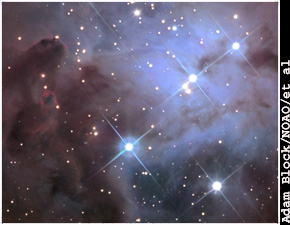Pluto is the ninth planet from the sun. It orbits at a distance of 3,647
million miles (nearly 40 times as far from the sun as Earth is).
With a diameter of only 1,485 miles, Pluto is the smallest planet in the
solar system.
The temperature on Pluto is -390°F.
It takes Pluto 248 Earth years to go around the sun one time, and 6 Earth
days to spin on its axis one time.
Scientists don't know if Pluto has an atmosphere or not. If it does, it
may be made of methane and nitrogen.
Pluto's surface has dark markings and is probably made of methane and nitrogen
ice.
Clyde Tombaugh discovered Pluto in 1930 at Lowell Observatory.
Because Pluto is smaller than many of the moons that orbit other planets,
some scientists think Pluto should be reclassified as an asteroid. But unlike most asteroids, Pluto is round like the planets.
To escape Pluto's gravity you need to travel 2,500 miles per hour.
 |

|
| |
Pluto and Charon
|
Pluto has one known moon, Charon, which was discovered in 1978. This moon
is about half as big as Pluto
Pluto was the god who ruled the dark underworld, a fitting name for the solar
system's darkly lit outer world.

